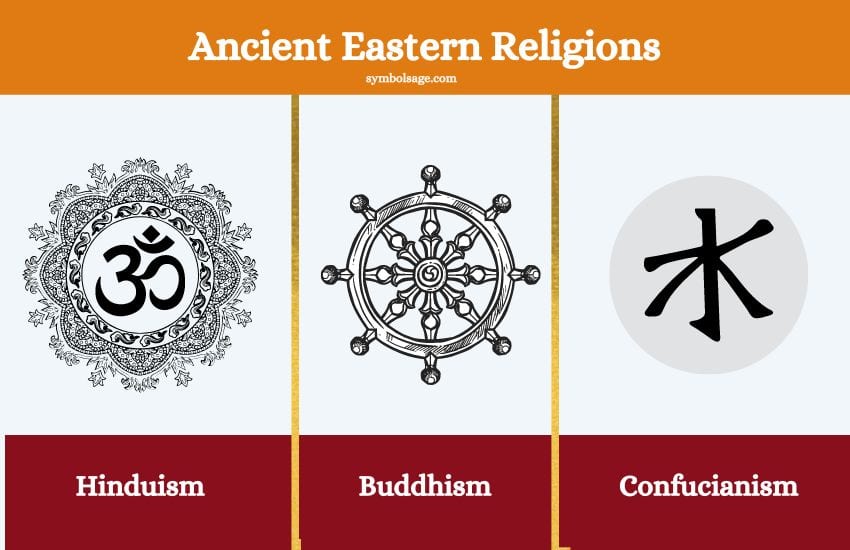
Table of Contents
Christianity is one of the world’s major religions, with over two billion adherents. It has a history that goes back over two thousand years. It’s also one of the most powerful religions, dominating in several regions, including much of Europe, Africa, Australia, the Americas, and more.
But while it remains one of the most powerful and influential religions, its roots have barely scratched the surface in the vast regions of the East. What stopped this globally influential faith from taking deep root in lands dominated by ancient traditions like Hinduism, Buddhism, and Confucianism?
Christianity’s spread in the East and its relative lack of dominance there is a multifaceted phenomenon influenced by historical, cultural, political, and religious factors. In this article, let’s explore why Christianity never really took over the East.
1. Presence of Ancient Eastern Religions

When Christianity began its expansion, Eastern regions like India, China, and much of Southeast Asia had already been deeply influenced by well-established religions and philosophies. This included Hinduism, Buddhism, and Confucianism.
These religions had existed for thousands of years in their respective regions and had shaped societal structures, values, and cultural practices for centuries. All this made it challenging for a new religion to gain widespread acceptance.
2. Geographical and Political Barriers
The enormous distances, formidable mountain ranges like the Himalayas, and vast deserts posed significant logistical challenges for early Christian missionaries. These natural impediments hindered the seamless flow of ideas, slowing the exchange of thoughts between the West and the East.
What’s more, several powerful empires, including the Chinese dynasties and the Indian empires, often controlled trade routes and had their own state-sponsored religions or philosophies.
The Nestorian Christian Stele documents early Christian activities in China during the Tang Dynasty. While initially tolerant, the dynasty later suppressed foreign religions, including Buddhism and Christianity, in favor of traditional Chinese beliefs like Daoism and Confucianism.
This would continue with other dynasties as well. And we also see this trend in other eastern cultures. In India, for example, only about 3 percent of the population are Christians today.
As the writer of this article states, “Christianity, probably for the first time, came up against a philosophy and culture that did not feel the need to persecute other faiths, did not find the Christian messiah and his teachings either objectionable or exceptional, and therefore, didn’t see why anyone should convert either.”
3. Limited Early Contact

Christianity’s early contact with the East was primarily through the Nestorian Christian Church. The Xian stele, which is also called the Nestorian stele, is a stone slab that was discovered in the 16 hundreds. It has text in Chinese and Syriac that describes the existence of early Nestorian Christian communities in parts of China.
According to Christianity Today, “The Nestorian Church had a high level of zeal for foreign mission. Throughout the sixth century, they sent missionaries across Central Asia, the Mongolian desert, China, and what is now India, establishing a large number of churches in these areas. The church spread throughout Western and Central Asia and along the Silk Road to China in the seventh century, providing the earliest encounter between Christianity and ancient Chinese civilization.”
However, this branch of Christianity was deemed heretical by mainstream Christian orthodoxy at the First Council of Ephesus in 431 CE. Because Nestorianism viewed Jesus as a god inspired man rather than as god himself, it was rejected by other Christian sects. While Nestorianism found followers in places like Persia and China, its isolation from mainstream Christianity might have limited the growth of Christianity in these areas.
4. Rise of Islam
By the 7th century, Islam began to spread rapidly across the Middle East and Central Asia.
Within a relatively short period after Muhammad’s death in 632 AD, Muslim armies had conquered a vast territory, spanning from Spain in the West to India in the East. Territories that once had significant Christian populations, such as Persia, were gradually Islamized.
This not only halted Christianity’s eastward expansion but also led to its decline in regions it once flourished. As a result of the Islamic conquests, the center of gravity of Christendom began to shift towards Europe.
Vestiges of these ancient Christian communities persist today in the Middle East, like the Coptic Christians in Egypt or the Assyrian Church of the East in Iraq. However, they often represent minority communities in predominantly Muslim nations.
5. Cultural Differences

Eastern societies had distinct worldviews, cultural practices, and philosophical traditions. These differences sometimes made it difficult for Christianity, with its Middle Eastern and Greco-Roman roots, to resonate with Eastern sensibilities.
For instance, the Christian concept of God and the teachings about sin and redemption did not align seamlessly with the cyclical views of existence in Hinduism and Buddhism. Christianity centers on a personal relationship with a monotheistic God, while many Eastern religions, like Buddhism and Taoism, often focus on personal enlightenment, cosmic principles, or a pantheon of deities rather than a singular, personal deity.
So naturally, Christianity stood out in stark contrast to these existing beliefs, and it never managed to establish a firm foothold in these regions.
6. Colonial Resistance
By the time European Christian missionaries reached the East during the Age of Discovery, they were often associated with colonial powers. A good example is the aggressive Christianization campaign carried out by the Portuguese in India.
In the 16th century, when the Portuguese first arrived on the western coast of India, they did so not only as traders but also as bearers of the Christian faith. Hindu temples in Portuguese territories were destroyed, and many cultural practices were outlawed. Many locals did convert (often due to force or socio economic benefits), but there was a profound mistrust and resistance against the Portuguese, who brought the Inquisition to their territories to control the population.
This colonial connection meant that converting to Christianity was sometimes seen as betraying one’s own culture and nation, leading to resistance.
7. Internal Christian Divisions

The Christian world itself was not monolithic. Differences between Catholic, Protestant, and Orthodox practices and beliefs, and sometimes competition among them, could hinder a unified approach to evangelism.
Countries in the East that Christianity Took Over

While Christianity did manage to create footholds in eastern societies, it was never able to take over these eastern cultures as it did in the west. But there are some outliers, like the Philippines, East Timor, and South Korea, where Christianity did take over or grow significantly.
The Philippines is the largest Christian country in Asia, with the majority of its population being Roman Catholic. This is largely a result of over three centuries of Spanish colonization, during which Catholicism was fervently promoted.
East Timor, or Timor-Leste, is another Southeast Asian nation where the majority of the population is Roman Catholic. The influence of Catholicism grew during Portuguese colonization and continued even after Indonesia, a majority Muslim country, annexed East Timor in 1975.
South Korea is also another Asian nation where there’s a significant Christian population, although it’s not majority Christian. Christianity has grown rapidly in the country over the last century, and today, it’s one of the religions with a strong presence in South Korea, alongside Buddhism.
Other countries in the Middle East, like Armenia, Georgia, Syria, and Lebanon also have significant Christian populations. But regardless of all that, when you think of the religions of the east, Christianity isn’t the first that comes to mind. India, China, Japan, Indonesia, Malaysia, Thailand, and many more continue to hold onto their traditional religions.
Wrapping Up
Regardless of Christianity’s efforts, the religion has grown but hasn’t been able to make as significant an impact as it has on Western culture and thought. This resistance to Christianity’s dominance is a testament to the deep roots of their own traditions and beliefs. And it highlights the fundamental differences in perspectives, outlook on life, and traditions between east and west.
Related articles
Descending Dove: A Potent Symbol Unique to Christianity
Ichthys Symbolism: From Pagan Origins to Christianity
Biblical Angels: Their Roles and Significance in Christianity
Types of Christianity Explained: Understanding the Differences








